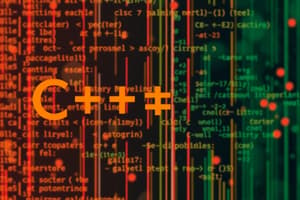Podcast
Questions and Answers
What is the primary function of the Control Unit in the CPU?
What is the primary function of the Control Unit in the CPU?
- Retrieving and decoding program instructions (correct)
- Storing program instructions and data
- Coordinating computer input and output
- Performing mathematical operations
What is the term for the smallest piece of memory?
What is the term for the smallest piece of memory?
- Byte
- Bit (correct)
- Word
- Bytecode
What is the main difference between main memory and secondary storage?
What is the main difference between main memory and secondary storage?
- Main memory is non-volatile, while secondary storage is volatile
- Main memory is used for input, while secondary storage is used for output
- Main memory is volatile, while secondary storage is non-volatile (correct)
- Main memory is faster, while secondary storage is larger
What is the role of the Arithmetic & Logic Unit (ALU) in the CPU?
What is the role of the Arithmetic & Logic Unit (ALU) in the CPU?
What is the primary function of operating system software?
What is the primary function of operating system software?
What is the primary distinction between single user and multiuser operating systems?
What is the primary distinction between single user and multiuser operating systems?
What is the primary purpose of a linker in the process of creating an executable file from a high-level program?
What is the primary purpose of a linker in the process of creating an executable file from a high-level program?
What is a characteristic of low-level programming languages?
What is a characteristic of low-level programming languages?
What happens when an error occurs during the process of creating an executable file from a high-level program?
What happens when an error occurs during the process of creating an executable file from a high-level program?
What is the term for a set of instructions directing a computer to perform a task?
What is the term for a set of instructions directing a computer to perform a task?
Flashcards are hidden until you start studying
Study Notes
Why Program?
- A computer is a programmable machine designed to follow instructions.
- A program is a set of instructions in computer memory that makes the computer do something.
- A programmer is a person who writes instructions (programs) to make a computer perform a task.
- Without programmers, there would be no programs, and without programs, the computer cannot do anything.
Computer Systems: Hardware and Software
- Main hardware component categories include:
- Central Processing Unit (CPU)
- Main memory (RAM)
- Secondary storage devices
- Input devices
- Output devices
Central Processing Unit (CPU)
- The CPU includes a Control Unit that retrieves and decodes program instructions, and coordinates computer operations.
- The CPU also includes an Arithmetic & Logic Unit (ALU) that performs mathematical operations.
- The CPU's role in running a program involves a cycle of:
- Fetch: getting the next program instruction from main memory
- Decode: interpreting the instruction and generating a signal
- Execute: routing the signal to the appropriate component to perform an operation
Main Memory
- Main memory holds both program instructions and data.
- Main memory is volatile, meaning it is erased when the program terminates or the computer is turned off.
- Main memory is also known as Random Access Memory (RAM).
Main Memory Organization
- A bit is the smallest piece of memory, represented by a binary digit (0 or 1).
- A byte is 8 consecutive bits.
- A word is usually 4 consecutive bytes, and has an address.
Secondary Storage
- Secondary storage is non-volatile, meaning data is retained even when the program is not running or the computer is turned off.
- Secondary storage comes in a variety of media, including magnetic, optical, and flash devices.
Input and Output Devices
- Input devices are used to send information to the computer from outside, and include devices such as keyboards, mice, and scanners.
- Output devices are used to send information from the computer to the outside, and include devices such as computer screens, printers, and speakers.
Software
- Operating system software manages the computer hardware and the programs that run on the computer.
- Application software provides services to the user, and includes programs such as word processing, games, and programs to solve specific problems.
Programs and Programming Languages
- A program is a set of instructions directing a computer to perform a task.
- A programming language is a language used to write programs.
- Types of programming languages include low-level languages (used for communication with computer hardware directly) and high-level languages (closer to human language).
Creating an Executable File
- To create an executable file, you need to:
- Create a file containing the program with a text editor.
- Run a preprocessor to convert source file directives to source code program statements.
- Run a compiler to convert source program statements into machine instructions.
- Run a linker to connect hardware-specific library code to machine instructions, producing an executable file.
- Errors occurring at any step will prevent execution of the following steps.
Studying That Suits You
Use AI to generate personalized quizzes and flashcards to suit your learning preferences.




